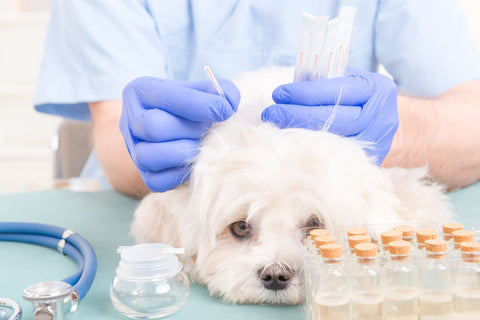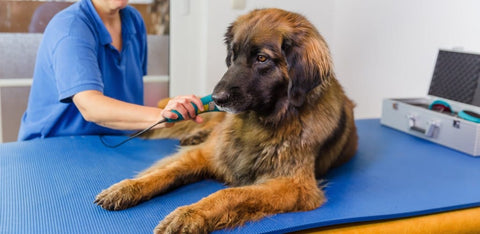

Hip dysplasia in dogs
Hip dysplasia in dogs is more common than many people realise, often showing up when pups are still quite young – typically between 6 and 12 months old. If you’re worried your dog might be affected, you’re not alone. Some of the most popular breeds are more likely to develop it, including dog breeds prone to hip dysplasia like Labradors, German Shepherds and French Bulldogs.
The reassuring news? We’ve learned a lot about what causes hip dysplasia in dogs, how to treat hip dysplasia in dogs, and even how to prevent hip dysplasia in dogs – so there’s plenty you can do to help your dog stay comfortable and active.
What is hip dysplasia in dogs?
Canine dysplasia refers to the abnormal development of a ball and socket joint. When it affects the hips – which work just like that – it’s known as hip dysplasia. In dogs with hip dysplasia, the joint doesn’t fit together as snugly as it should. Over time, this causes extra wear and tear, leading to joint inflammation, pain and eventually the telltale signs of hip dysplasia in dogs.
Signs of hip dysplasia in dogs
You’ll often notice the signs of canine hip dysplasia because your dog starts to move differently – often due to pain in the joint. When the hip doesn’t sit properly in the socket, every step can become uncomfortable, so your dog may naturally avoid running, jumping or even getting up.
Common signs of hip pain include:
- Limping
-
Joint stiffness, especially after resting
- Reluctance to run, play or climb stairs
- Difficulty getting up or lying down
Other signs of hip dysplasia in dogs can develop gradually, such as:
- Behavioural changes – pain can make dogs more withdrawn or sensitive to touch
- Muscle atrophy – if your dog isn’t using their hips as much, the muscles around the joint can weaken over time

What are the first signs of hip dysplasia?
The first signs of hip dysplasia in dogs can be easy to miss. They’re often subtle, especially in puppies, and may even be mistaken for personality quirks or harmless habits. But if you know what to watch for, these early clues can help you spot the condition sooner – and get the right help from your vet.
Keep an eye out for mild, early-stage signs like:
-
Your dog sitting in an unusual way – for example, with one leg flopped out to the side or their bottom tucked underneath and both legs to one side
-
Hesitation to jump up on the sofa or bed – it might seem like they’re just well behaved, but it could be that their hips are sore
- Bunny hopping – this is when dogs run with both back legs moving together in a sort of hop. It might look cute or quirky, but it’s not typical movement, and can be one of the first visible signs of hip dysplasia in dogs
End stage hip dysplasia
If left untreated, hip dysplasia in dogs can progress to osteoarthritis in the hip joints – a long-term, painful condition that can be managed but not cured. That’s why spotting the signs early is so important.
Signs of advanced or end-stage hip dysplasia in dogs can include:
- Limping that doesn’t improve with rest
- Loss of muscle tone in the back legs
- Refusal to climb stairs, jump into the car or sit down during walks
- Wobbly back legs or slipping when moving around
- Mood changes – your dog might sleep more than usual, seem withdrawn or become snappy if their back end is touched unexpectedly
When dogs are in pain, it can affect their whole quality of life – so if you spot any of these signs, it’s best to book a check-up with your vet. They can talk you through a range of options, including joint supplements, medication, tailored weight-loss plans or physiotherapy.
Your vet will also be able to suggest small, practical ways to support your dog at home. From non-slip mats on hard floors to ramps for garden steps, simple changes can make a big difference. After all, your dog spends most of their time at home – so the more we can do to keep that environment comfortable, the better.

What causes hip dysplasia in dogs?
Most of the risk of developing hip dysplasia comes down to genetics – it’s largely inherited from a puppy’s parents. But how severely it affects a dog can be influenced by other factors too, such as their weight, how their bones develop and how much exercise they get as a puppy. It’s a complex condition, and without the right management early on – like keeping exercise controlled during those crucial growth stages – the signs of hip dysplasia can become more pronounced.
Is hip dysplasia genetic in dogs?
Hip dysplasia in dogs is largely a genetically inherited condition. If you're thinking about getting a puppy, one of the best ways to reduce the risk is to choose a responsible breeder. Look for someone who health-tests their dogs and uses tools like Hip Scoring to assess the parents’ joint health before breeding. A good breeder will be open about their dogs’ medical history and won’t breed from lines with known hip issues in the family.
Dog breeds prone to hip dysplasia
Some dog breeds prone to hip dysplasia include:
-
Golden Retrievers
-
Labradors
- French Bulldogs
-
German Shepherds
-
Rottweilers
- St Bernards
- Great Danes
These breeds are often larger or heavier-set, which can put more strain on their joints as they grow. If you share your home with one of these dogs, it’s worth being extra mindful of their hip health from an early age.
How to help prevent hip dysplasia in dogs
While it’s not always possible to completely prevent hip dysplasia in dogs, there are steps you can take to reduce the risk. Because it’s a genetically inherited condition, choosing a puppy from health-tested parents – ideally with good Hip Scores – is a strong starting point.
If you already have a puppy, don’t worry. There’s still a lot you can do to support their developing joints. Make sure they’re fed the right amount for their age and breed to avoid excess weight gain, and be mindful not to overdo exercise while they’re still growing. Too much activity too soon can put extra pressure on developing hips, increasing the chance of pain and inflammation.
How to treat hip dysplasia in dogs
There are several ways to manage hip dysplasia in dogs, and the right approach depends on how severe the condition is.
In milder cases, lifestyle changes can make a big difference. Weight management, joint supplements, and regular physiotherapy or hydrotherapy for dogs can all help to reduce pain and keep your dog moving comfortably.
For more advanced cases, surgery may be recommended – often followed by a tailored rehab plan including physio or hydrotherapy. If surgery isn’t an option, your vet can help manage the signs of hip dysplasia with long-term pain relief and supportive care, helping your dog stay as happy and active as possible.



